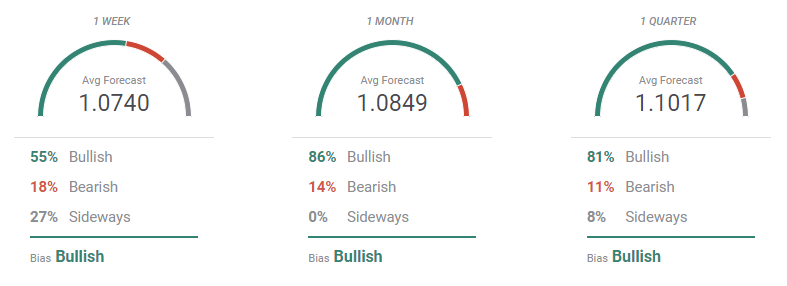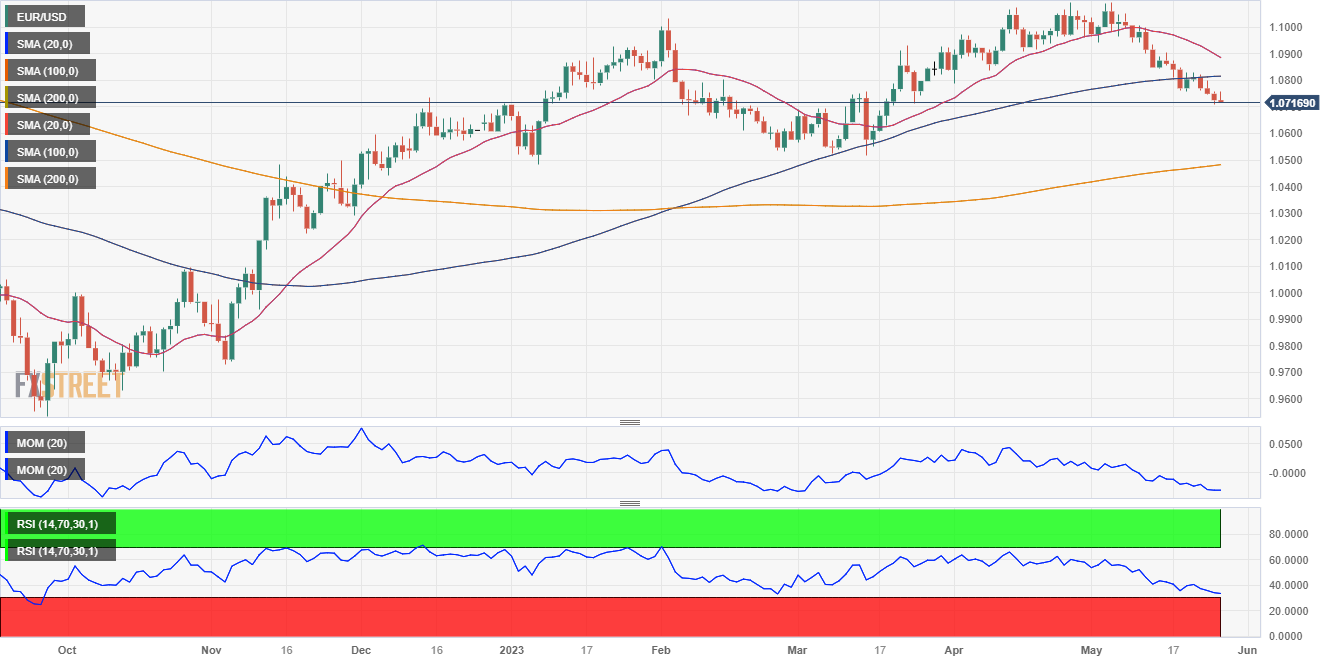- Concerns about the US debt ceiling maintained markets in risk-off mode.
- United States data suggest the Federal Reserve could extend the tightening cycle.
- EUR/USD bearish case deepens, but sentiment has the final saying.
The EUR/USD pair fell for a third consecutive week and flirts with the 1.0700 level ahead of the close, as demand for the US Dollar extended into the weekly close.
Financial markets have been all about sentiment these last few days, with the focus on the United States (US) debt ceiling. Treasury Secretary Janet Yellen triggered the alarm a couple of weeks ago, saying that if Congress does not agree on an extension, the country could default as soon as June 1. Ever since, President Joe Biden and top congressmen have engaged in negotiations, mostly focused on spending levels. Opposition Republicans would agree on a higher debt ceiling should the Government compromise with spending cuts.
Back and forths were reported this week, with House Speaker Kevin McCarthy mainly noting progress has been made, but there are still some divergences while affirming the county will not fall into default. The market mood improved modestly on Friday after Deputy Treasury Secretary Wally Adeyemo reported progress in negotiations, but Euro strength was short-lived.
Data surprises
The US Dollar got an additional boost from stronger-than-anticipated local data, which also raised doubts about the Federal Reserve's (Fed) next steps. The Q1 Gross Domestic Product (GDP) was upwardly revised to 1.3% from the previous estimate of 1.1%. Firmer growth would allow the central bank to extend its monetary tightening cycle for one or two more meetings.
In fact, the Federal Open Market Committee (FOMC) Minutes showed that American policymakers were divided on the rate path, with some of them still looking for more hikes. Furthermore, the country published the Personal Consumption Expenditures (PCE) Price Index, which rose by 4.4% on a yearly basis in April from 4.2% in March, while core PCE inflation increased by 4.7% YoY, higher than the previous 4.6%. The PCE Price Index is the Fed’s favorite inflation gauge, and rising figures support the case for another rate hike, particularly if the economy continues growing at an encouraging pace.
European data, on the other hand, reflect a more fragile economic stance. The German GDP was downwardly revised to -0.3% QoQ, following a preliminary estimate of 0%. Annualized growth came in at -0.5%, worse than the -0.1% previously calculated. Other German data released these days also weighed on the Euro, as the May IFO survey on Business Climate contracted by more than anticipated, to 91.7, while the June Gfk Consumer Confidence Survey printed at -24.2, worse than the -24 expected.
The upcoming week will bring more interesting macroeconomic data. Germany will report the preliminary estimate of the May Harmonized Index of Consumer Prices (HICP) and April Retail Sales. The Eurozone will also publish the preliminary estimate of the May HICP, foreseen up by 6.3% YoY, while the European Central Bank (ECB) will publish the Monetary Policy Meeting Accounts. Finally, the US will publish the May ISM Manufacturing PMI and the Nonfarm Payrolls report. The country is expected to have added 180K new jobs in May, while the Unemployment Rate is expected to remain steady at 3.4%.
It is still unclear whether the US Dollar could preserve its latest strength in a risk-on scenario. A potential agreement over the US debt ceiling would likely spark optimism. There is a good chance US lawmakers will clinch a deal about the debt-ceiling extension over the weekend, something that happened multiple times in the last few years. That could boost the market sentiment ahead of the new week. Gaps could be expected in the upcoming Asian opening if the scenario is confirmed.

EUR/USD technical outlook
The EUR/USD pair is hovering below the 61.8% Fibonacci retracement of the 2022 yearly decline at 1.0745, and a clear break below it would harm bulls’ conviction, resulting in a steeper decline in the upcoming days. The weekly chart shows that the pair is developing below all its moving averages, with the 20 Simple Moving Average (SMA) now flat at around 1.0805 and providing dynamic resistance.
At the same time, the 100 SMA accelerated south above the shorter one, reflecting increased selling interest. Finally, the Momentum indicator is about to cross below its 100 level, although lacking directional strength, while the Relative Strength Index (RSI) indicator heads firmly south at around 50, anticipating another leg south without confirming it.
The bearish case is more evident in the daily chart, as the pair extends its slide below the 20 and 100 SMAs, with the shorter gaining downward traction above the longer one. Technical indicators remain within negative levels with modest downward slopes but also without anticipating a potential reversal.
Once below the 1.0700 figure, the pair could find support around 1.0660, while below the latter, the fall should continue towards the 1.0500/40 price zone. The pair needs now to regain 1.0800 to spook bears, while a daily close above 1.0805 could anticipate a bullish continuation towards the 1.0900 area.
EUR/USD sentiment poll
The FXStreet Forecast Poll suggests the Greenback will lose the battle, as EUR/USD is seen bullish in the three time-frame under study. Bulls stand at 55% of the polled experts on a weekly basis but jump to 86% in the monthly view and 81% in the quarterly perspective. On average, the pair is seen back above 1.1000 by the end of the period.
At the same time, the Overview chart shows that the near-term moving average has lost its bearish slope and consolidates at around 1.0800, while the longer ones also offer neutral slopes. Interestingly enough, the pair is seen mostly between 1.0600 and 1.1000 in the monthly view, but between 1.1000 and 1.1400 in the quarterly one, suggesting market players expect a downward correction ahead of a fresh rally.

Information on these pages contains forward-looking statements that involve risks and uncertainties. Markets and instruments profiled on this page are for informational purposes only and should not in any way come across as a recommendation to buy or sell in these assets. You should do your own thorough research before making any investment decisions. FXStreet does not in any way guarantee that this information is free from mistakes, errors, or material misstatements. It also does not guarantee that this information is of a timely nature. Investing in Open Markets involves a great deal of risk, including the loss of all or a portion of your investment, as well as emotional distress. All risks, losses and costs associated with investing, including total loss of principal, are your responsibility. The views and opinions expressed in this article are those of the authors and do not necessarily reflect the official policy or position of FXStreet nor its advertisers. The author will not be held responsible for information that is found at the end of links posted on this page.
If not otherwise explicitly mentioned in the body of the article, at the time of writing, the author has no position in any stock mentioned in this article and no business relationship with any company mentioned. The author has not received compensation for writing this article, other than from FXStreet.
FXStreet and the author do not provide personalized recommendations. The author makes no representations as to the accuracy, completeness, or suitability of this information. FXStreet and the author will not be liable for any errors, omissions or any losses, injuries or damages arising from this information and its display or use. Errors and omissions excepted.
The author and FXStreet are not registered investment advisors and nothing in this article is intended to be investment advice.
Recommended Content
Editors’ Picks

EUR/USD stays near 1.0400 in thin holiday trading
EUR/USD trades with mild losses near 1.0400 on Tuesday. The expectation that the US Federal Reserve will deliver fewer rate cuts in 2025 provides some support for the US Dollar. Trading volumes are likely to remain low heading into the Christmas break.

GBP/USD struggles to find direction, holds steady near 1.2550
GBP/USD consolidates in a range at around 1.2550 on Tuesday after closing in negative territory on Monday. The US Dollar preserves its strength and makes it difficult for the pair to gain traction as trading conditions thin out on Christmas Eve.

Gold holds above $2,600, bulls non-committed on hawkish Fed outlook
Gold trades in a narrow channel above $2,600 on Tuesday, albeit lacking strong follow-through buying. Geopolitical tensions and trade war fears lend support to the safe-haven XAU/USD, while the Fed’s hawkish shift acts as a tailwind for the USD and caps the precious metal.

IRS says crypto staking should be taxed in response to lawsuit
In a filing on Monday, the US International Revenue Service stated that the rewards gotten from staking cryptocurrencies should be taxed, responding to a lawsuit from couple Joshua and Jessica Jarrett.

2025 outlook: What is next for developed economies and currencies?
As the door closes in 2024, and while the year feels like it has passed in the blink of an eye, a lot has happened. If I had to summarise it all in four words, it would be: ‘a year of surprises’.

Best Forex Brokers with Low Spreads
VERIFIED Low spreads are crucial for reducing trading costs. Explore top Forex brokers offering competitive spreads and high leverage. Compare options for EUR/USD, GBP/USD, USD/JPY, and Gold.
